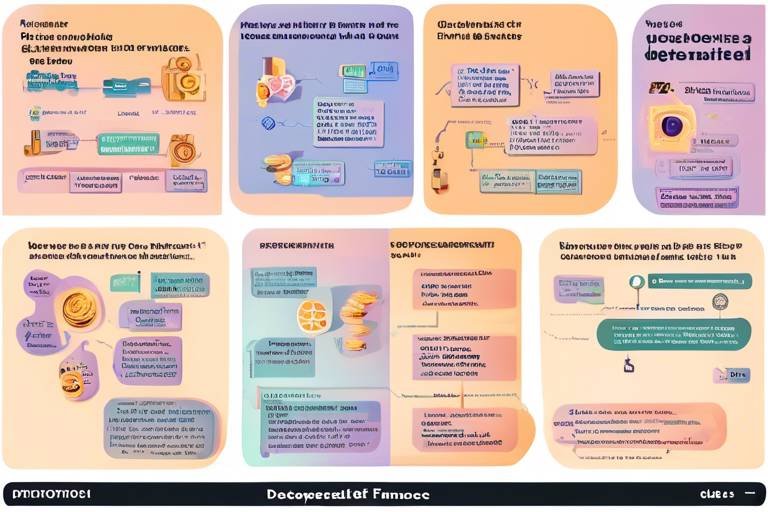How Blockchain Can Enhance the Efficiency of Public Transportation
Imagine a world where public transportation is not only reliable but also incredibly efficient. Sounds like a dream, right? Well, with the advent of blockchain technology, this dream is becoming a reality. This innovative technology, often associated with cryptocurrencies, has the potential to revolutionize public transportation systems worldwide. By leveraging the unique characteristics of blockchain, such as decentralization, transparency, and security, we can address many of the challenges currently faced by public transport. In this article, we will explore how blockchain can enhance the efficiency of public transportation, diving into its benefits, applications, and the hurdles that lie ahead.
At its core, blockchain technology is a decentralized ledger system. It allows multiple parties to access and verify data without the need for a central authority. This means that all transactions are recorded in a way that is secure and transparent, making it nearly impossible for any single entity to manipulate the information. The implications of this technology are profound, especially for industries like public transportation, where data integrity and real-time information are crucial. By ensuring that all stakeholders—from passengers to operators—have access to the same data, blockchain fosters trust and collaboration.
Implementing blockchain in public transportation can lead to a multitude of benefits that can significantly enhance operational efficiency. Some of the most notable advantages include:
- Improved Efficiency: By streamlining processes and reducing delays.
- Reduced Fraud: Enhancing transparency makes fraudulent activities harder to execute.
- Enhanced Data Security: Protecting sensitive information from unauthorized access.
These benefits not only improve the overall user experience for passengers but also optimize operations for transport providers. Imagine waiting at a bus stop and knowing exactly when your bus will arrive, all thanks to real-time data sharing made possible by blockchain technology.
One of the standout features of blockchain is its ability to facilitate real-time data sharing among various stakeholders in the public transportation ecosystem. This capability leads to better decision-making and resource allocation. For instance, if a bus is running late due to traffic, operators can instantly notify passengers through a mobile app, allowing them to adjust their plans accordingly. This level of communication not only improves the user experience but also enhances operational efficiency by reducing unnecessary delays and optimizing routes.
With blockchain, public transport vehicles can be tracked in real-time, providing accurate information to both passengers and operators. This means that passengers can receive updates about their transport options, while operators can monitor vehicle performance and maintenance needs. The implications of real-time tracking are profound for service reliability, as it allows for quick responses to unexpected issues. Imagine a scenario where a train is delayed; with blockchain, passengers can receive instant updates, reducing uncertainty and frustration.
The decentralized nature of blockchain enhances data security significantly. Since the data is stored across multiple nodes rather than a single central server, it becomes extremely difficult for malicious actors to manipulate information. This is particularly important in public transportation, where sensitive data, such as personal information and payment details, are involved. The robust security features of blockchain can help protect this data, ensuring that passengers feel safe when using public transport services.
Another compelling application of blockchain in public transportation is its ability to simplify payment processes. Traditional payment methods can often be cumbersome and slow, leading to long queues and frustrated passengers. However, with blockchain, transactions can be completed swiftly and securely. This not only reduces transaction times but also lowers costs for both operators and passengers. Imagine tapping your card and instantly boarding a bus without waiting for a ticket to print—this is the future that blockchain promises.
Despite its transformative potential, the implementation of blockchain in public transportation is not without challenges. Various obstacles need to be addressed to fully realize its benefits. Some of these challenges include:
- Regulatory Concerns: The legal landscape surrounding blockchain is still evolving, and navigating these regulations is crucial for successful adoption.
- Technological Integration: Merging blockchain with existing public transportation systems can be complicated and requires significant investment.
Addressing these challenges will be essential for the successful integration of blockchain technology in public transportation systems. Stakeholders must collaborate to create a regulatory framework that accommodates innovation while ensuring safety and security.
Q: How does blockchain improve transparency in public transportation?
A: Blockchain provides a decentralized ledger that allows all stakeholders to access the same data, ensuring transparency and reducing the likelihood of fraud.
Q: Can blockchain technology reduce operational costs?
A: Yes, by streamlining processes and enabling faster transactions, blockchain can significantly reduce operational costs for transport providers.
Q: What are the main challenges in adopting blockchain in public transport?
A: The primary challenges include navigating regulatory concerns and integrating blockchain technology with existing systems.

Understanding Blockchain Technology
Blockchain technology is often described as a decentralized ledger system that revolutionizes the way we store and share data. Imagine a digital notebook that everyone can see, but no one can erase or alter. This is the essence of blockchain—transparency and security rolled into one. Each entry in this digital notebook is called a "block," and these blocks are linked together in a chronological order, forming a "chain." Hence, the term "blockchain."
The fundamental principles of blockchain revolve around three core concepts: decentralization, transparency, and security. Unlike traditional databases managed by a single entity, blockchain operates on a network of computers, or nodes, that share and validate the information. This decentralization means that no single party has control over the entire system, which significantly reduces the risk of fraud and corruption.
In terms of transparency, every participant in the network has access to the same information, which fosters trust among users. For instance, if you were to buy a ticket for public transportation, both you and the transportation authority would have access to the same transaction record. This eliminates discrepancies and misunderstandings, ensuring that everyone is on the same page.
Moreover, the security aspect of blockchain cannot be overstated. Each block is encrypted and linked to the previous one through cryptographic hashes, making it nearly impossible for anyone to tamper with the data. If someone tried to alter a block, the entire chain would be affected, alerting the network to the inconsistency. This feature is particularly vital in industries like public transportation, where data integrity is crucial for operational efficiency and passenger safety.
To illustrate how blockchain can be applied across various industries, consider the following table:
| Industry | Application of Blockchain |
|---|---|
| Finance | Secure transactions, reducing fraud |
| Healthcare | Patient data management, ensuring privacy |
| Supply Chain | Tracking products from origin to consumer |
| Public Transportation | Real-time tracking, secure payments |
As we delve deeper into the potential of blockchain in public transportation, it's essential to recognize that while this technology offers numerous benefits, its implementation is not without challenges. Understanding the underlying principles of blockchain provides a solid foundation for grasping its transformative potential in various sectors, especially in enhancing the efficiency of public transport systems.

Benefits of Blockchain in Public Transportation
Implementing blockchain technology in public transportation systems can lead to a revolution in how services are delivered and managed. Imagine a world where every bus, train, or tram is connected through a transparent, secure network that not only enhances efficiency but also builds trust among users. This technology offers numerous advantages, such as improved efficiency, reduced fraud, and enhanced data security. Let's dive deeper into these benefits and see how they can transform public transport.
One of the most significant benefits of blockchain is its ability to improve data management. In traditional systems, data is often siloed, leading to inefficiencies and poor decision-making. However, with blockchain, real-time data sharing among various stakeholders—such as transport operators, government agencies, and passengers—becomes a reality. This real-time connectivity allows for better resource allocation, enabling transport authorities to respond swiftly to changing demands and optimize routes accordingly.
When we talk about real-time data sharing, think of it as a conductor coordinating an orchestra. Each musician (or transport vehicle) needs to know exactly when to play their part for the entire symphony to sound harmonious. In public transportation, this means that operators can monitor vehicle locations, passenger counts, and traffic conditions in real-time. By utilizing blockchain, transport systems can share this data instantly, leading to better decision-making and a smoother overall experience for passengers.
Imagine waiting for a bus that never seems to arrive. Frustrating, right? With blockchain, public transport vehicles can be tracked in real-time, providing accurate information to both passengers and operators. This transparency means passengers can receive updates on arrival times, delays, and even seat availability, making their travel experience much more reliable. The implications of this technology extend beyond mere convenience; they can significantly enhance service reliability and customer satisfaction.
Another remarkable aspect of blockchain is its enhanced security. The decentralized nature of this technology makes it incredibly difficult for malicious actors to manipulate information. In a world where data breaches are all too common, blockchain provides a robust solution. By ensuring that all transactions and data entries are immutable and traceable, public transportation systems can protect sensitive information and maintain trust among users. This level of security is crucial, especially when dealing with personal data and payment information.
Moreover, blockchain can streamline payment processes within public transportation, making transactions faster and more efficient. Traditional payment systems often involve multiple intermediaries, leading to delays and additional costs. Blockchain can eliminate these intermediaries, allowing for seamless transactions between passengers and operators. Imagine tapping your card or smartphone and instantly boarding your bus without waiting in line or fumbling for cash. This not only enhances the user experience but also reduces operational costs for transport providers.
In summary, the benefits of blockchain in public transportation are profound. From improved data management and real-time tracking to enhanced security and streamlined payments, this technology has the potential to revolutionize the way we think about public transit. As we continue to explore these possibilities, it's essential to consider not only the advantages but also the challenges that come with implementing such transformative technology.
- What is blockchain technology?
Blockchain technology is a decentralized ledger system that records transactions across multiple computers, ensuring transparency and security.
- How does blockchain improve public transportation?
It enhances data management, provides real-time tracking, improves security, and streamlines payment processes.
- What are the challenges of implementing blockchain?
Challenges include regulatory concerns and technological integration with existing systems.

Improved Data Management
Imagine a world where data flows seamlessly between public transportation operators, passengers, and regulatory bodies. With blockchain technology, this vision is not just a dream—it's becoming a reality. Blockchain enhances data management by enabling real-time data sharing among various stakeholders, which is crucial for effective decision-making and resource allocation. In traditional systems, data is often siloed, leading to inefficiencies and delays. However, with blockchain, every transaction and operational detail is recorded on a decentralized ledger, accessible to all authorized parties. This transparency fosters trust and accountability, which are essential in public transportation.
One of the most compelling aspects of blockchain is its ability to provide a single source of truth. For instance, if a bus is delayed, real-time updates can be shared instantly across the network. Passengers can check the status of their ride on their smartphones, while operators can adjust schedules and allocate resources more effectively. This interconnectedness not only improves the overall passenger experience but also helps operators manage their fleets more efficiently. Imagine a bus system where delays are minimized because operators can respond proactively to real-time data. That's the power of improved data management through blockchain.
Moreover, the enhanced data management capabilities of blockchain can lead to significant cost savings. By reducing the time spent on data reconciliation and minimizing errors, public transportation systems can allocate their resources more effectively. For example, consider a scenario where multiple agencies are involved in public transport—each with its own data systems. Traditionally, reconciling data between these agencies can be time-consuming and prone to errors. However, with blockchain, all relevant data can be updated and verified in real-time, drastically reducing administrative overhead.
To illustrate the potential benefits, let's take a look at a simple comparison table:
| Traditional System | Blockchain System |
|---|---|
| Data silos among agencies | Unified, accessible data for all stakeholders |
| Delayed updates and communication | Real-time updates and notifications |
| High administrative costs | Reduced costs through streamlined processes |
In conclusion, the integration of blockchain technology into public transportation systems can significantly enhance data management. By fostering real-time data sharing, creating a single source of truth, and reducing administrative costs, blockchain paves the way for smarter, more efficient public transport solutions. As we move forward, the question is not whether blockchain will impact public transportation, but rather how quickly we can harness its potential for the benefit of all.

Real-Time Tracking
Imagine standing at a bus stop, checking your watch, and feeling that familiar twinge of anxiety as you wonder where your bus is. Now, picture a world where you can see the exact location of your bus in real-time, right on your smartphone. This is where powered by blockchain technology comes into play, revolutionizing the way we interact with public transportation.
By leveraging blockchain, public transport systems can provide accurate, up-to-the-minute data on vehicle locations. This means that passengers no longer have to rely on outdated schedules or guesswork. Instead, they can access live updates that inform them of delays, changes in routes, or early arrivals. Not only does this enhance the overall travel experience, but it also fosters a sense of trust between the passengers and the transport providers. After all, who doesn't appreciate knowing exactly when their ride will arrive?
Furthermore, real-time tracking has significant implications for service reliability. When transport operators can monitor their fleet in real-time, they can make informed decisions on resource allocation. For instance, if a bus is running late, operators can quickly deploy another vehicle to cover the route, minimizing the impact on passengers. This dynamic approach to fleet management ensures that services remain consistent and dependable, ultimately leading to higher customer satisfaction.
Additionally, the data collected through real-time tracking can be used to analyze patterns and trends within the public transportation system. This information can help identify peak travel times, allowing operators to adjust their schedules and resources accordingly. For example, if a certain route consistently sees a surge in passengers during rush hour, operators can increase the frequency of buses during that time, significantly improving the overall efficiency of the service.
In a nutshell, real-time tracking enabled by blockchain technology not only enhances the passenger experience but also optimizes operational efficiency for transport providers. By providing transparent and reliable information, blockchain fosters a more responsive and agile public transportation system, making it a game-changer in the industry.
- How does real-time tracking work with blockchain? Real-time tracking uses blockchain to securely share data between vehicles and transport operators, providing up-to-date information to passengers.
- What are the benefits of real-time tracking for passengers? Passengers benefit from accurate arrival times, reduced wait times, and increased trust in the public transport system.
- Can real-time tracking help reduce operational costs? Yes, by optimizing fleet management and resource allocation, real-time tracking can lead to significant cost savings for transport operators.

Enhanced Security
In an age where data breaches and cybersecurity threats loom large, the offered by blockchain technology is a game-changer for public transportation systems. By utilizing a decentralized ledger, blockchain ensures that data is not stored in a single location, making it significantly more challenging for malicious actors to tamper with or manipulate information. Imagine a world where every transaction, every record, and every piece of data is securely locked away, accessible only to those with the right permissions. This is the promise of blockchain.
One of the standout features of blockchain is its use of cryptographic techniques, which safeguard data integrity. Each transaction is encrypted and linked to the previous one, creating an unbreakable chain of information. This means that once data is recorded on the blockchain, it becomes nearly impossible to alter without being detected. For public transportation systems, this translates to a robust safeguard against fraud and unauthorized access. For instance, if a ticketing system is built on a blockchain platform, any attempt to forge a ticket would be easily identifiable due to the immutable nature of the records.
Moreover, the transparency inherent in blockchain technology fosters trust among users. With a public ledger, passengers can verify the legitimacy of their transactions in real-time. This transparency not only helps in building confidence in the system but also encourages accountability among operators. When passengers know that every fare collected and every service rendered is recorded transparently, it creates a culture of responsibility. Blockchain, therefore, acts as a digital watchdog, ensuring that all stakeholders play by the rules.
However, the benefits of enhanced security don't stop there. Blockchain can also facilitate secure identity verification processes, which is particularly crucial in public transportation. For example, passengers can have digital identities stored on the blockchain, allowing for seamless and secure boarding processes. This reduces the risk of identity theft and ensures that only authorized individuals can access certain services. Think of it as having a high-tech bouncer at the entrance of a nightclub, verifying that everyone who enters is indeed on the guest list.
In summary, the enhanced security provided by blockchain technology not only protects data but also builds trust and accountability within public transportation systems. As cities continue to evolve and embrace technology, the integration of blockchain could very well be the key to a safer, more reliable public transport experience.

Streamlining Payments
Imagine stepping onto a bus or train and simply walking through the turnstile without fumbling for cash or swiping a card. Blockchain technology can make this dream a reality by revolutionizing payment processes in public transportation. By leveraging the power of decentralized ledgers, blockchain can create a seamless, efficient, and secure payment system that benefits both operators and passengers.
One of the most significant advantages of using blockchain for payments is the ability to facilitate instant transactions. Traditional payment methods often involve multiple intermediaries, leading to delays and increased transaction costs. With blockchain, payments can be executed in real-time, allowing passengers to board quickly without long queues. This not only enhances the passenger experience but also optimizes the flow of vehicles on the road, reducing congestion and improving overall service efficiency.
Furthermore, blockchain can significantly reduce transaction fees associated with payment processing. Currently, public transportation systems often incur high costs due to credit card processing fees, chargebacks, and fraud prevention measures. By utilizing blockchain, these costs can be minimized as transactions are processed directly between users without the need for intermediaries. This creates a win-win situation where operators can save money and potentially pass those savings on to passengers through lower fares.
Another critical aspect is the enhanced security that blockchain offers. In a world where data breaches and fraud are rampant, the decentralized nature of blockchain makes it incredibly difficult for malicious actors to tamper with transaction records. Each transaction is encrypted and linked to the previous one, creating a chain that is virtually unbreakable. This means passengers can trust that their financial information is secure, fostering greater confidence in using public transportation systems.
To illustrate the potential impact of blockchain on payment systems, consider the following table that compares traditional payment methods with blockchain-based transactions:
| Feature | Traditional Payment Methods | Blockchain-Based Payments |
|---|---|---|
| Transaction Speed | Minutes to hours | Instant |
| Transaction Fees | High (2-5% per transaction) | Low (near-zero fees) |
| Security | Vulnerable to fraud | Highly secure and tamper-proof |
| User Experience | Complex and time-consuming | Simple and efficient |
Moreover, blockchain can also facilitate the implementation of smart contracts in public transportation payment systems. These self-executing contracts with the terms of the agreement directly written into code can automate various processes, such as fare calculations based on distance traveled or time of day. This not only streamlines operations but also ensures that passengers are charged fairly and transparently.
In conclusion, the integration of blockchain technology into public transportation payment systems holds immense potential for streamlining operations, enhancing security, and improving the overall user experience. As cities around the world continue to innovate and adapt to changing technological landscapes, embracing blockchain could be the key to creating a more efficient, reliable, and user-friendly public transportation system.
- What is blockchain technology?
Blockchain is a decentralized ledger technology that records transactions across many computers securely and transparently.
- How can blockchain improve public transportation?
It can enhance efficiency, reduce fraud, streamline payments, and improve data management.
- Are there any challenges to implementing blockchain in public transport?
Yes, challenges include regulatory concerns and technological integration with existing systems.

Challenges of Implementing Blockchain
While the potential of blockchain technology in public transportation is undeniably exciting, it is essential to recognize the challenges that come with its implementation. These obstacles can hinder the seamless integration of blockchain into existing systems, making it crucial for stakeholders to address them proactively. One of the most significant challenges is navigating the complex regulatory landscape. Governments and regulatory bodies often lag behind technological advancements, leading to legal uncertainties surrounding the use of blockchain in public transport. This can create an environment of hesitation among operators who might be wary of investing in a technology that lacks clear legal guidelines.
Furthermore, the technological integration of blockchain with existing public transportation systems poses another significant hurdle. Many current systems are built on legacy technology that may not be compatible with blockchain solutions. This lack of interoperability can lead to increased costs and resource allocation challenges, as public transport authorities will need to invest in upgrading their infrastructure. In addition, the complexity of blockchain technology itself can be daunting for organizations that are not technically savvy. They may require extensive training and education to fully understand and leverage blockchain's capabilities.
Moreover, there is the issue of data privacy. While blockchain is renowned for its security features, the transparency it offers can sometimes conflict with privacy concerns. For instance, if passenger data is recorded on a public blockchain, it could potentially be accessed by unauthorized parties. Striking a balance between transparency and privacy is a challenge that needs careful consideration. To mitigate these concerns, it may be necessary to explore the use of private or permissioned blockchains, which can offer greater control over who accesses sensitive information.
Finally, the cost of implementation cannot be overlooked. Transitioning to a blockchain-based system requires significant investment in technology, infrastructure, and training. Many public transportation agencies operate with tight budgets, and allocating resources to implement blockchain solutions can be a tough sell. It is vital for stakeholders to conduct thorough cost-benefit analyses to justify the investment and ensure that the long-term benefits outweigh the initial expenses.
In summary, while the promise of blockchain in public transportation is immense, the challenges of regulatory compliance, technological integration, data privacy, and cost must be addressed. By working collaboratively to find solutions to these issues, the public transport sector can harness the full potential of blockchain technology, ultimately leading to a more efficient and reliable system for all.
- What is blockchain technology? Blockchain is a decentralized ledger system that records transactions across many computers in a way that the registered transactions cannot be altered retroactively.
- How can blockchain improve public transportation? Blockchain can enhance efficiency, security, and transparency in public transportation systems by enabling real-time data sharing and streamlining payment processes.
- What are the main challenges of implementing blockchain? The primary challenges include regulatory concerns, technological integration, data privacy issues, and the cost of implementation.
- Is blockchain secure? Yes, the decentralized nature of blockchain makes it difficult for malicious actors to manipulate data, enhancing overall security.

Regulatory Concerns
When it comes to integrating blockchain technology into public transportation, one of the most significant hurdles is navigating the complex web of . The legal landscape surrounding blockchain is still evolving, and many government entities are struggling to keep up with the rapid pace of technological advancements. As a result, public transportation agencies must tread carefully to ensure compliance with existing laws while advocating for the adoption of this innovative technology.
One of the primary issues is the lack of standardized regulations that specifically address blockchain applications. Different regions may have varying laws regarding data privacy, financial transactions, and even the use of decentralized systems. This inconsistency can create confusion and hinder collaboration among transportation operators, technology providers, and regulatory bodies. For instance, while one city may welcome blockchain solutions for ticketing and payments, another may impose strict data protection laws that could limit the technology's effectiveness.
Moreover, the question of liability arises when blockchain is involved in public transportation. If a transaction goes awry or data is compromised, determining who is responsible can be a complex issue. Is it the transportation agency, the blockchain provider, or the user? This ambiguity can discourage stakeholders from investing in blockchain solutions, fearing potential legal repercussions.
To address these regulatory challenges, a collaborative approach is essential. Stakeholders in the public transportation sector must engage with policymakers to advocate for clear and comprehensive regulations that facilitate the safe and effective use of blockchain technology. Establishing a dialogue between technology developers, transportation agencies, and regulatory bodies can lead to more informed decision-making and a better understanding of the potential benefits and risks of blockchain.
Additionally, creating pilot programs can serve as a testing ground for blockchain applications in public transport. These programs can provide valuable data and insights that help shape future regulations while demonstrating the technology's advantages. By showcasing successful implementations, stakeholders can build trust and confidence in blockchain's ability to enhance public transportation systems.
In summary, while regulatory concerns present significant challenges to the adoption of blockchain in public transportation, they are not insurmountable. Through collaboration and open communication, stakeholders can work together to create a regulatory environment that supports innovation while ensuring safety and compliance. The future of public transportation could very well depend on how effectively these regulatory challenges are addressed.
- What are the main regulatory challenges for blockchain in public transportation? The primary challenges include the lack of standardized regulations, issues of liability, and varying laws across different regions.
- How can stakeholders address these regulatory concerns? By engaging with policymakers, advocating for clear regulations, and creating pilot programs to test blockchain applications.
- Why is regulatory compliance important for blockchain adoption? Compliance ensures that the technology can be implemented safely and effectively, reducing legal risks for all parties involved.

Technological Integration
Integrating blockchain technology into existing public transportation systems is akin to fitting a square peg into a round hole. It’s not just about introducing a new technology; it’s about making sure that this innovative solution harmonizes with the established infrastructure. The challenge lies in the fact that many public transport systems are built on legacy technologies that may not be compatible with blockchain's decentralized nature. This means that transit authorities need to consider several factors before making the leap.
First and foremost, technical compatibility is a significant hurdle. Most public transportation systems rely on outdated software and hardware, which can complicate the integration of blockchain. For example, if a city’s transport system uses a specific ticketing platform, it must be assessed whether that platform can interface with a blockchain-based solution. This often requires a comprehensive overhaul of existing systems, which can be both time-consuming and costly.
Moreover, the implementation of blockchain requires significant investment in new technologies. This includes not only the blockchain software itself but also the necessary hardware upgrades to support it. For instance, public transport operators may need to invest in new mobile devices for staff, upgraded servers, and enhanced cybersecurity measures. The cost of this transition can be daunting, especially for municipalities with tight budgets. Therefore, a clear cost-benefit analysis is essential before proceeding.
Another critical aspect of technological integration is training and education. Staff at all levels must understand how blockchain technology works and how it will impact their daily operations. This means conducting comprehensive training programs that cover everything from basic blockchain principles to specific operational protocols. If employees are not adequately trained, the likelihood of successful implementation diminishes significantly.
Furthermore, public transportation systems must also address interoperability. This refers to the ability of different blockchain systems to work together seamlessly. With various stakeholders involved—such as transit agencies, payment processors, and users—ensuring that all parties can communicate and share data effectively is paramount. A lack of interoperability can lead to fragmented systems, which can ultimately undermine the efficiency that blockchain aims to achieve.
To facilitate the integration process, stakeholders should consider forming collaborative partnerships. By working together, transit authorities can share resources, knowledge, and best practices, making the transition smoother. For instance, partnerships with technology firms specializing in blockchain can provide valuable insights and support, helping to navigate the complexities of integration.
In summary, while the integration of blockchain into public transportation systems presents several challenges, it also offers a pathway to enhanced efficiency and security. By addressing technical compatibility, investing in new technologies, providing adequate training, ensuring interoperability, and fostering collaborative partnerships, public transport authorities can set the stage for a successful implementation of blockchain solutions.
- What is blockchain technology?
Blockchain technology is a decentralized ledger system that records transactions across multiple computers, ensuring that the data is secure and transparent. - How can blockchain improve public transportation?
Blockchain can enhance public transportation by improving data management, enabling real-time tracking, and streamlining payment processes. - What are the main challenges of implementing blockchain in public transport?
The main challenges include regulatory concerns, technological integration, and the need for staff training. - Is blockchain secure?
Yes, the decentralized nature of blockchain makes it highly secure, as it is difficult for malicious actors to manipulate the information stored within it.
Frequently Asked Questions
- What is blockchain technology?
Blockchain technology is a decentralized ledger system that records transactions across many computers in such a way that the registered transactions cannot be altered retroactively. This ensures transparency and security, making it an ideal solution for various industries, including public transportation.
- How can blockchain improve public transportation efficiency?
By implementing blockchain, public transportation systems can enjoy improved data management, real-time tracking, and streamlined payment processes. This leads to better decision-making, enhanced service reliability, and reduced transaction times, ultimately making the entire system more efficient.
- What are the benefits of real-time tracking in public transport?
Real-time tracking allows passengers to receive accurate and timely information about vehicle locations and expected arrival times. This enhances the overall travel experience by reducing wait times and improving service reliability for both passengers and operators.
- Are there any security advantages of using blockchain in public transportation?
Absolutely! The decentralized nature of blockchain significantly enhances data security. It makes it extremely difficult for malicious actors to manipulate or alter information, thereby protecting sensitive data related to public transportation operations and passenger information.
- What challenges does blockchain face in public transportation?
Blockchain implementation in public transportation faces several challenges, including regulatory concerns and technological integration issues. Navigating the legal landscape and ensuring compatibility with existing systems are critical hurdles that need to be addressed for successful adoption.
- How can regulatory concerns impact blockchain adoption?
Regulatory concerns can significantly impact blockchain adoption as outdated laws may not accommodate new technologies. It's essential for policymakers to update regulations to support blockchain's integration into public transportation, ensuring compliance and fostering innovation.
- What is the future of blockchain in public transportation?
The future looks promising! As technology continues to evolve and more stakeholders recognize the benefits of blockchain, we can expect to see broader adoption and innovative applications in public transportation, leading to enhanced efficiency and improved user experiences.



















